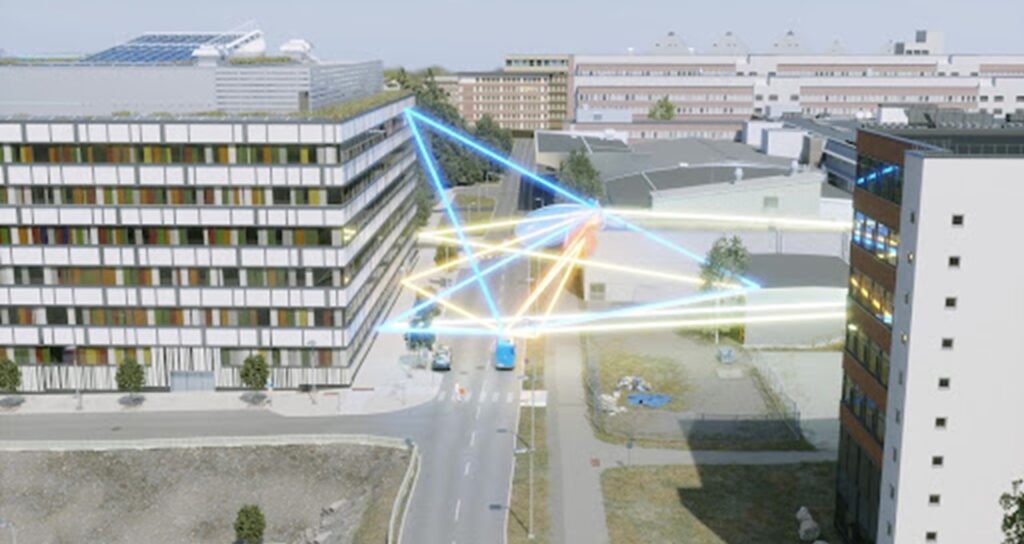The metaverse needs 5G, and maybe the other way around too
The public metaverse is years away from being practically deployed, and to do so will take some fundamental changes to 5G and hyperscaler infrastructure, say stakeholders. But metaverse technology — the integration and overlay of physical and digital “twins” — exists today and is being used to solve practical problems, like how to cover a city optimally with 5G coverage capable of supporting a public metaverse infrastructure, in the first place. Being able to flawlessly digitally recreate a real network is also driving innovations in distributed cloud architectures for Communication Service Providers (CSPs).
“Metaverse” is arguably the telecom and hyperscaler buzzword du jour. In broad strokes, the metaverse is described as a new way of interacting online, mixing cloud data with the real world — 3D virtual worlds which we’ll experience using new devices, each with rich social connections and interactions weaved in.
The headsets may have gotten sleeker and the software’s improved. But superficially, this metaverse thing sounds to jaded older ears like a retread of the same “cyberspace” VR concepts we’ve heard about since the 1990s. Indeed, “the metaverse of…[subject]” is already almost cliché among the torrent of press releases from tech startups and established giants alike looking to cash in, or at least get some visibility from the metaverse hype.
What “metaverse” ultimately means is entirely up to who’s talking about it. If you listen to Meta (née Facebook), it’s their metaverse. If you ask Nvidia, they’ll offer their own Omniverse as a solution. New metaverses, and metaverse concepts, are hopping up continuously. But the metaverse, or metaverses, at least that idea of it, requires foundational technology that is still in development.
Rima Qureshi, EVP and chief strategy officer of Verizon, recently underscored that sentiment during the company’s investor day presentation. She said that Extended Reality (XR) rendering in the cloud requires some key enabling technologies to be developed to deliver low-latency and high-bandwidth customer experiences.
Building foundational metaverse technology
“When we started building 5G Ultra Wideband, we were most excited by the use cases that were not yet envisioned. Take the metaverse, for example. Over the next decade, the metaverse will create virtual spaces that are more immersive and realistic than ever before, providing people with unique ways to connect across work, home, and play,” said Qureshi.

Developing this new metaverse technologies, Qureshi said, will require material investment from Verizon and Meta both.
“Some features of the metaverse will require that cloud computing infrastructure move closer to end users. Our efforts will enable both companies to measure the impact of edge computing on key application performance metrics and evaluate where our network capabilities can enable more powerful metaverse-optimized applications,” Qureshi added.
Metaverse technology is very dependent on the development of edge computing and storage resources. That’s because — at least as it stands now — producing the rich media content to create a metaverse experience will require very low latency and very high bandwidth connectivity.
Shortly before the Verizon and Meta announcement — in fact, on the eve of this year’s Mobile World Congress in Barcelona — Meta Vice President Dan Rabinovitsj posted a manifesto of sorts on Meta’s corporate blog pages. Rabinovitsj said that carriers will need to shape up their networks if they expect the metaverse to work. And building out a solid edge is vital.
“We envision a future where remote rendering over edge cloud, or some form of hybrid between local and remote rendering, plays a greater role in the years to come. And enabling remote rendering will require both fixed and mobile networks to be rearchitected to create compute resources at a continuum of distances to end users,” said Rabinovitsj.
Meta wants carriers to make significant advancements starting with network latency, symmetrical bandwidth and the overall speed of networks. But that’s not where it ends.
“Delivering such an experience will require innovations in fields like hybrid local and remote real-time rendering, video compression, edge computing, and cross-layer visibility, as well as spectrum advocacy, work on metaverse readiness of future connectivity and cellular standards, network optimizations, improved latency between devices and within radio access networks (RANs), and more,” said Rabinovitsj.
Using metaverse technology today to make 5G better
That’s that Metaverse. But there’s more than one. “Metaverse” has become a useful catchphrase to describe all manner of VR and “digital twin” efforts, which are being used now to solve problems — like how to deploy 5G to begin with.
Nvidia’s Omniverse is an ambitious collaborative metaverse environment which Ericsson has enlisted to build “digital twins” of real-world cities. These digital recreations of real-world environments sport a level of detail that enables Ericsson’s engineers to accurately predict how 5G signal strength and performance antennas to find the best combination of performance and coverage, long before a technician ever arrives to install it.

While they never mention the metaverse, the digital twin concept is mirrored in Nokia’s Adaptive Cloud Network solution. Staging servers — practice versions where you can deploy a website or cloud app before it goes live for the rest of the world — are very familiar territory for the cloud and a pretty basic concept in the DevOps realm. Adaptive Cloud Network’s “Digital Sandbox” takes the idea to the next level, according to Nokia’s Pat McCabe.
The virtual represents the real down to the smallest atomic detail in what Nokia calls a “Digital Sandbox” that enables network operations personnel to simulate changes to the network before any changes are made. It’s an integral part of Nokia’s intent-based automation toolkit for network operations, or NetOps for short.
“It replicates the exact production network. So, every leaf and spine in the data center fabric is recreated in our digital sandbox by a service within a container in the digital sandbox structure. That allows us to validate any network change before it becomes deployed through the digital sandbox,” said McCabe.
The digital sandbox is receiving continuous telemetry from the network, said McCabe. “That telemetry information gives you everything you need to know to actually behave and emulate every leaf and every spine right up the configuration, right up to the state. It remains parity in state as well as configuration.”
This enables carriers to make changes in the digital sandbox, test thoroughly, make sure there are no unexpected problems, and then deploy changes seamlessly and instantly, making the virtual real.
“This dramatically de-risks any changes that are needed in the network,” McCabe added.
Bottom line: There’s an undeniable synergy between 5G and the metaverse at every level. Carriers, hyperscalers and other stakeholders are wasting no time finding ways to monetize and use the metaverse even as they’re working to build the foundational technology to make it work for the masses.
For more about 5G and telco cloud, download this free report.

